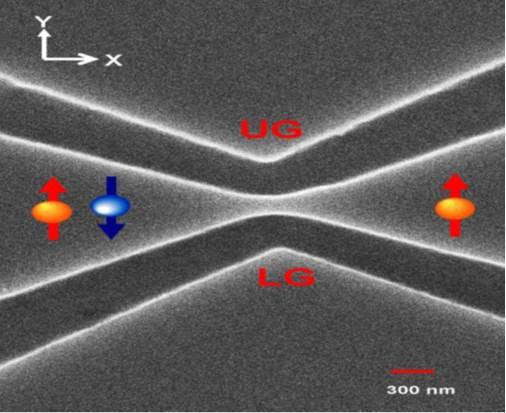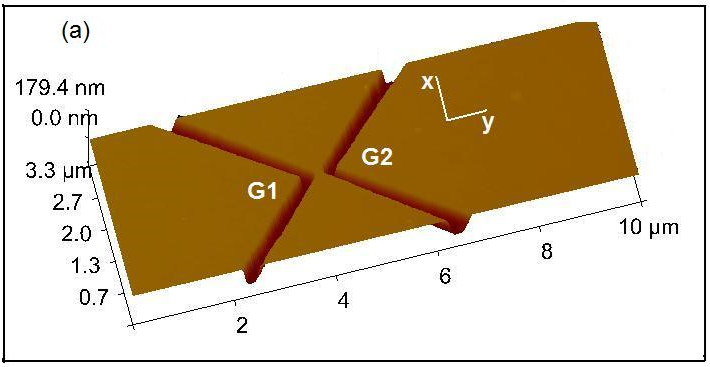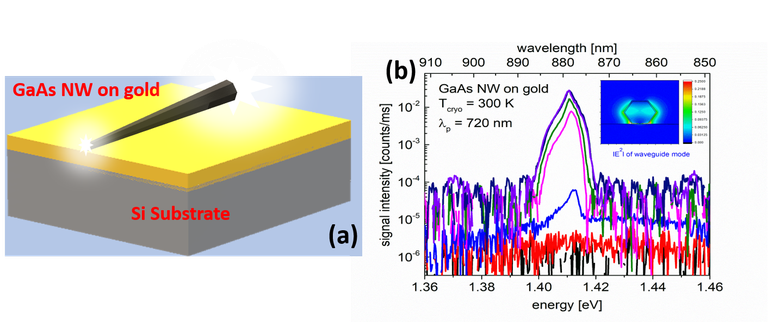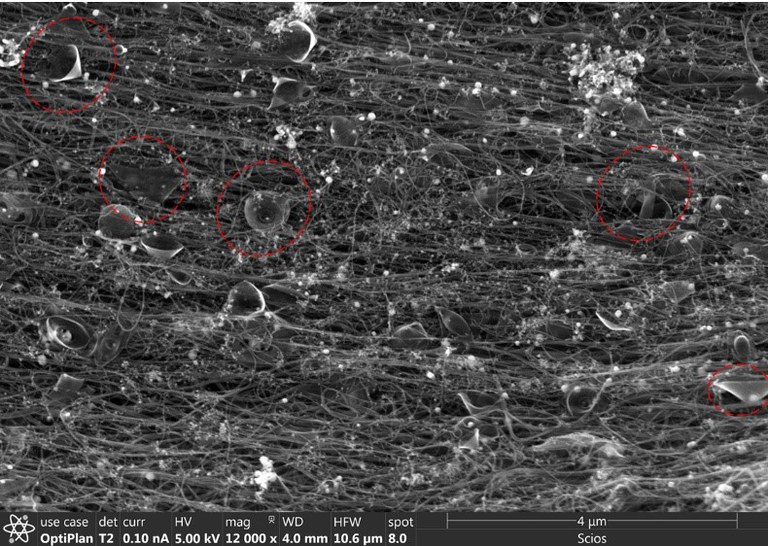Research Information
Research
Our laboratory has 36 year experience in the field of nanoscience and nanotechnology and vacuum micro- and nano-electronics. We have published over 155 refereed journal papers and 60 refereed conference proceedings papers in these areas. Our research has been supported by the National Science Foundation, the Air Force Office of Scientific Research, and various companies. Our director, Professor Cahay is an active member of the Electrochemical Society (ECS) for which he has co-edited of 11 proceedings volumes of symposia on quantum confinement and cold cathodes. He is also an active member of IEEE and has been on the board of the IEEE Technical Committee on Spintronics and Nano-magnetism since 2002. Over the years, he has served on the program committees of 30 international conferences.
His current research focus areas are as follows:
Multicale Model of Field Emission from Carbon Nanotubes
We have developed a multi-scale model of field emission (FE) from carbon nanotube fibers (CNFs) which takes into account Joule heating within the fiber and radiative cooling and the exchange mechanisms at the tip of the individual carbon nanotubes (CNTs) in the array located at the fiber tip. The model predicts the fraction of CNTs being destroyed as a function of the applied external electric field and reproduces many experimental features observed in some recently investigated CNFs such as, order of magnitude of the emission current (mA range), low turn on electric field (fraction of V/µm), deviation from pure Fowler-Nordheim behavior at large applied electric field, hysteresis of the FE characteristics, and a spatial variation of the temperature along the CNF axis with a maximum close to its tip of a few hundred oC. The Scanning Electron Microscope (SEM) pictures on the left show partial destruction of some of the CNTs close to the tip of the fiber as recorded after FE experiments. These pictures indicate that FE not only occur at the tip but also from the sides of the CNF.
fiber and radiative cooling and the exchange mechanisms at the tip of the individual carbon nanotubes (CNTs) in the array located at the fiber tip. The model predicts the fraction of CNTs being destroyed as a function of the applied external electric field and reproduces many experimental features observed in some recently investigated CNFs such as, order of magnitude of the emission current (mA range), low turn on electric field (fraction of V/µm), deviation from pure Fowler-Nordheim behavior at large applied electric field, hysteresis of the FE characteristics, and a spatial variation of the temperature along the CNF axis with a maximum close to its tip of a few hundred oC. The Scanning Electron Microscope (SEM) pictures on the left show partial destruction of some of the CNTs close to the tip of the fiber as recorded after FE experiments. These pictures indicate that FE not only occur at the tip but also from the sides of the CNF.
This work is done in collaboration with Steve Fairchild, Tyson Back, and Paul Murray in the Materials and Manufacturing Directorate at Wright-Patterson Air Force Base and is supported by the Air Force Office of Scientific Research.
Selected publications in this area include:
- M. Cahay, W. Zhu, S. Fairchild, P.T. Murray, T.C. Back, and G. Gruen, “Multiscale Model of Heat Dissipation Mechanisms During Field Emission from Carbon Nanotube Fibers”, Applied Physics Letters 108, 033110 (2016).
- M. Cahay, W. Zhu, J. Ludwick, K. L. Jensen, R. G. Forbes,S. B. Fairchild, T. C. Back, P. T. Murray, J. R. Harris, and D. A. Shiffler, “Optimizing the Field Emission Properties of Carbon Nanotube Based Fibers”, Nanotube Superfiber Materials, Science, Manufacturing, and Commercialization, Edited by Mark Schulz, Vesselin Shanov, Zhanghang Yin, and Marc Cahay (Elsevier, 2018).
- W. Zhu, M. Cahay, J. Ludwick, K. L. Jensen, R. G. Forbes, S. B. Fairchild, T. C. Back, P. T. Murray, J. R. Harris, and D. A. Shiffler, “Multiscale Modeling of Field Emission Properties of Carbon Nanotube Based Fibers”, Nanotube Superfiber Materials, Science, Manufacturing, and Commercialization, Edited by Mark Schulz, Vesselin Shanov, Zhanghang Yin, and Marc Cahay (Elsevier, 2018).
Spintronics Using Quantum Point Contacts
Lateral spin orbit coupling (LSOC) resulting from the lateral in-plane electric field of the confining potential of a side-gated quantum point contact (QPC) (Fig.1(a)) can be used to create strongly spin-polarized current by purely electrical means1 in  the absence of any applied magnetic field. Using a non- equilibrium Green’s function (NEGF) analysis of a small model QPC2-5, three ingredients have been found to sufficient conditions to generate the strong spin polarization: an asymmetric lateral confinement, a LSOC induced by the lateral confining potential of the QPC, and a strong electron-electron (e-e) interaction. In the past, we have studied the evolution of anomalous conductance plateaus as a function of the potential difference between the two side gates of an In0.52Al0.48As/InAs quantum point contact in the presence of LSOC. As shown in Fig.1(b), the conductance anomalous plateau is only observed over a limited range of bias asymmetry. When the bias difference is large enough, there is a substantial increase in the electron density on one side of the narrow portion of the quantum point contact. As a result, there is an enhancement in the screening of the electron-electron interaction and the anomalous plateau disappears.
the absence of any applied magnetic field. Using a non- equilibrium Green’s function (NEGF) analysis of a small model QPC2-5, three ingredients have been found to sufficient conditions to generate the strong spin polarization: an asymmetric lateral confinement, a LSOC induced by the lateral confining potential of the QPC, and a strong electron-electron (e-e) interaction. In the past, we have studied the evolution of anomalous conductance plateaus as a function of the potential difference between the two side gates of an In0.52Al0.48As/InAs quantum point contact in the presence of LSOC. As shown in Fig.1(b), the conductance anomalous plateau is only observed over a limited range of bias asymmetry. When the bias difference is large enough, there is a substantial increase in the electron density on one side of the narrow portion of the quantum point contact. As a result, there is an enhancement in the screening of the electron-electron interaction and the anomalous plateau disappears.
This work was supported by the National Science Foundation.
Selected publications in this area include:
- P. Debray, S.M.S. Rahman, J. Wan, R.S. Newrock, M. Cahay, A.T. Ngo, S.E. Ulloa, S.T. Herbert, M. Muhammad, and M. Johnson, Nature Nanotech. 4, 759 (2009).
- J. Wan, M. Cahay, P. Debray, and R.S. Newrock, Phys. Rev. B 80, 155440 (2009).
- N. Bhandari, M. Dutta, J. Charles, M. Cahay, and R.S. Newrock, ”Hysteresis in the Conductance of Asymmetrically Biased Quantum Point Contacts with In-Plane Side Gates”, J. Appl. Physics 114, 033702 (2013)
- J. Charles, M. Cahay, and R.S. Newrock, ”Intrinsic Bistability in Quantum Point Contacts in the Presence of Lateral Spin-Orbit Coupling”, Applied Physics Letters 102, 112413 (2013).
-
J. Charles, N. Bhandari, J. Wan, M. Cahay, and R.S. Newrock, ”Tunable All-Electric Spin Polarizer”, Applied Physics Letters 102, 062419 (2013).
- R. S. Newrock, N. Bhandari, M. Cahay, and S. T. Herbert, “Steps toward an all-electric spin valve using side-gated Quantum Point Contacts with Lateral Spin Orbit Coupling”, Advances in Natural Sciences: Nanoscience and Nanotechnology 4, 013002 (2013).
- M. Cahay, “Prospect for An All-Electric Spin Field Effect Transistor With Semiconductors”, News and Views, Nature Nanotechnology 10, pp.21-22 (2014).
- P. Das, A. Jones, M. Cahay, S. Kalita, N. S. Sterin, T. R. Yadunath, M. Advaitha, and S. T. Herbert, “Dependence of the 0.5x(2e2/h) conductance plateau on the aspect ratio of InAs quantum point contacts with in-plane side gates”, Journal of Applied Physics 121 (8), 083901 (2017).
- P. Das, M. Cahay, S.S. Mal, and A.K. Jha, “Width dependence of the 0.5Go (Go = 2e2/h) conductance plateau and accompanying hysteresis loop in InAs quantum point contacts in the presence of lateral spin-orbit coupling”, Scientific Reports (2019).


(Left) Conductance of a QPC measured as a function of the bias difference between the two side gates.
(Rigth) AFM scan of single InAs QPC with side gates G1 and G2.
Secondary Electron Suppression from Microporous Surfaces
 In an effort to reduce secondary electron emission (SEE) from lowering efficiency or even leading to failure in high powered electromagnetic systems, we have fabricated and measured SEE from gold surfaces with laser drilled microporous surfaces. An example of a laser drilled surface is shown in the image to the left. We have tested the SEE reduction effectiveness from a variety of porous arrays and incident electron impact angles and have shown that increasing pore density and aspect ratio (pore height/diameter) significantly reduces SEE from all incidence angles. Additionally, we have developed a high accuracy empirical model to determine SEE yields as a function of incidence angle as well as a Monte Carlo simulation tool to predict SEE from microporous surfaces that is in excellent agreement with experiment.
In an effort to reduce secondary electron emission (SEE) from lowering efficiency or even leading to failure in high powered electromagnetic systems, we have fabricated and measured SEE from gold surfaces with laser drilled microporous surfaces. An example of a laser drilled surface is shown in the image to the left. We have tested the SEE reduction effectiveness from a variety of porous arrays and incident electron impact angles and have shown that increasing pore density and aspect ratio (pore height/diameter) significantly reduces SEE from all incidence angles. Additionally, we have developed a high accuracy empirical model to determine SEE yields as a function of incidence angle as well as a Monte Carlo simulation tool to predict SEE from microporous surfaces that is in excellent agreement with experiment.
This work is supported by the Air Force Office of Scientific Research and is done in collaboration with Asif Iqbal and Peng Zhang at Michigan State University, Daniel Gortat, Jack Cook, Martin Sparkes, and William O’Neil at the University of Cambridge, and Steve Fairchild and Tyson Back in the Materials and Manufacturing Directorate at Wright-Patterson Air Force Base.
Selected publications in this area include:
- A. Iqbal, J. Ludwick, S. Fairchild, M. Cahay, D. Gortat, M. Sparkes, W. O’Neill, T.C. Back, and P. Zhang, “Empirical modeling and Monte Carlo simulation of secondary electron yield reduction of laser drilled microporous gold surfaces” Journal of Vacuum Science & Technology B 38, 013801 (2020).
- J. Ludwick, A. Iqbal, D. Gortat, J. Cook, M. Cahay, P. Zhang, T. Back, S. Fairchild, M. Sparkes, and W. O’Neil, “Angular dependence of secondary electron yield from microporous gold surfaces” (to be submitted to Journal of Vacuum Science & Technology B)
Ultracompact Hybrid-Plasmonic Nanodevices For Lasing
 We are investigating optically pumped plasmonic and photonic lasing from highly Zn doped GaAs NWs on gold and gold coated GaAs NWs. The typical length of these NWs is in the range of 3-5 µm. The GaAs NWs were grown by Au catalyzed metal-organic vapor phase epitaxy (MOVPE), the size of the Au catalysts was 100 nm. The high doping concentration increases both the radiative efficiency and material gain to enable lasing at temperatures ranging from 5 K up to room temperature.
We are investigating optically pumped plasmonic and photonic lasing from highly Zn doped GaAs NWs on gold and gold coated GaAs NWs. The typical length of these NWs is in the range of 3-5 µm. The GaAs NWs were grown by Au catalyzed metal-organic vapor phase epitaxy (MOVPE), the size of the Au catalysts was 100 nm. The high doping concentration increases both the radiative efficiency and material gain to enable lasing at temperatures ranging from 5 K up to room temperature.
We use “finite-difference time-domain simulations” to calculate various nanolaser relevant parameters and waveguide modes in these structures. Figure (a) sketches a lasing GaAs NWs on a gold film. Figure (b) shows the lasing spectra from GaAs NW on gold at 300 K and the simulated hybrid photonic-plasmonic mode profile in the NWs.
The aim of our experiments is to demonstrate the benefits of hybrid plasmonic lasing when the nanowire diameter is approaching the optical diffraction limit. The results open new prospects for on-chip integration and the development of GaAs-based ultra-compact plasmonic devices.
This work is performed in collaboration with Professor Hans-Peter Wagner at Department of Physics, University of Cincinnati.
Selected publications in this area include:
- G. Aman, F. Mohammadi, M. Lysevych, H. Tan, C. Jagadish, H. Schmitzer, M. Fraenzl, M. Cahay, and H. P. Wagner, "Hybrid Plasmonic Lasing from Zinc-Doped GaAs Nanowires up to Room Temperature," in Frontiers in Optics + Laser Science APS/DLS, The Optical Society (Optical Society of America, 2019), paper JW3A.55.
Chemical Deactivation Membrane for Air and Water Filtration
 Carbon nanotube hybrid (CNTH) material is multifunctional material synthesize at a high temperature gas phase pyrolysis process. The multifunctional properties such as light weight, excellent electrical and mechanical properties and porous nature of the CNT make it suitable for the filtering applications. The filter consists of CNTH fabric integrated with nanoparticles will capture and deactivate the toxics from the filter membranes. The Scanning Electron Microscope (SEM) picture shows the vacancies to capture toxic particles.
Carbon nanotube hybrid (CNTH) material is multifunctional material synthesize at a high temperature gas phase pyrolysis process. The multifunctional properties such as light weight, excellent electrical and mechanical properties and porous nature of the CNT make it suitable for the filtering applications. The filter consists of CNTH fabric integrated with nanoparticles will capture and deactivate the toxics from the filter membranes. The Scanning Electron Microscope (SEM) picture shows the vacancies to capture toxic particles.
The ongoing research is in collaboration with Professor Mark Schulz at Department of Mechanical Engineering and Dr. Peter Kosel at Department of Electrical Engineering and Computer Science at University of Cincinnati.
Selected publications in this area include:
- Daniel Rui Chen, Megha Chitranshi, Mark Schulz, Vesselin Shanov. “A review of three major factors controlling carbon nanotube synthesis from the floating catalyst chemical vapor deposition” is published in Nano LIFE.
- Book chapters in Nanotube Superfiber Materials: Science, Manufacturing, Commercialization M Schulz, V Shanov, Z Yin, M Cahay.
- Megha Chitranshi, Devika Chauhan, Ashley Kubley, Anuptha Pujari, Chenhao Xu, Daniel Chen, Sumeet Chaudhary, Guangfeng Hou, Gregory Bell, Brooke Brandewie, Rutvik Kaneria, Ronald Hudepohl, Mark J Schulz, Pioneering carbon nanotube textile engineering & fashion technology. J Textile Eng Fashion Technol. 2019;5(2):89‒92.
